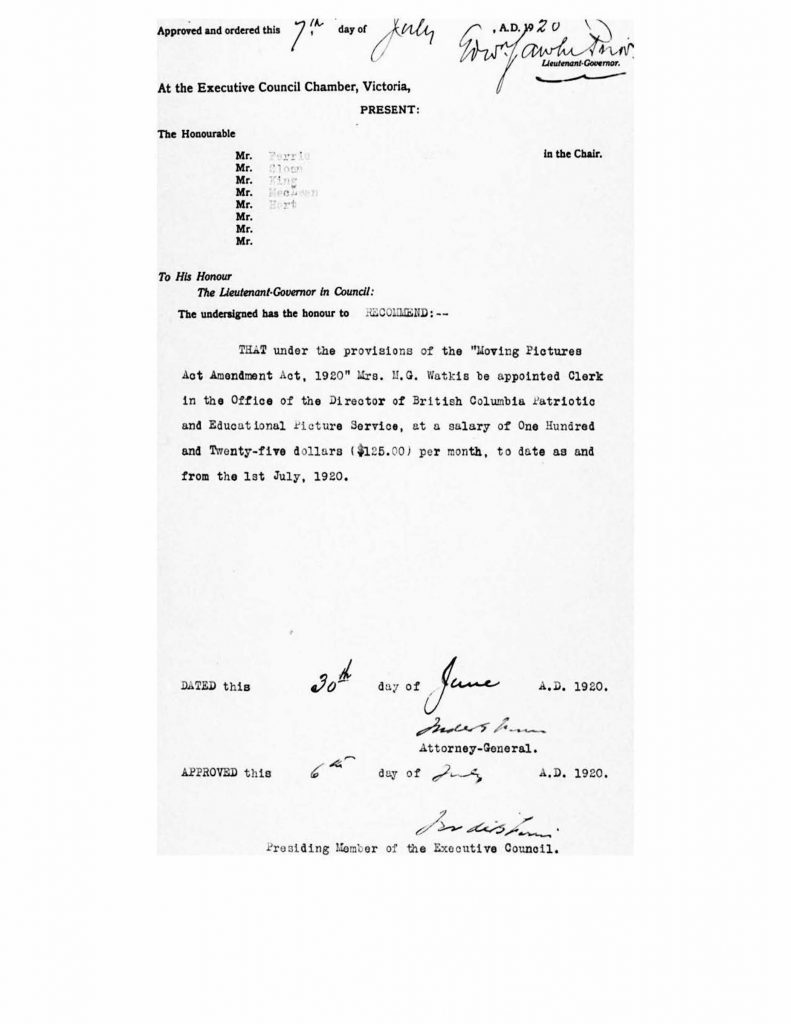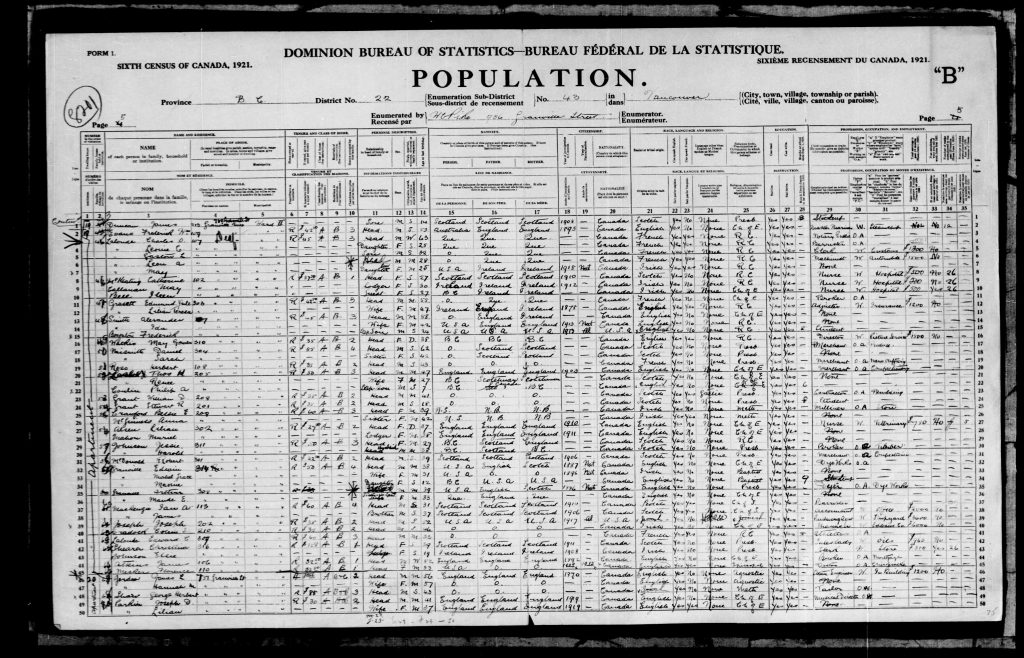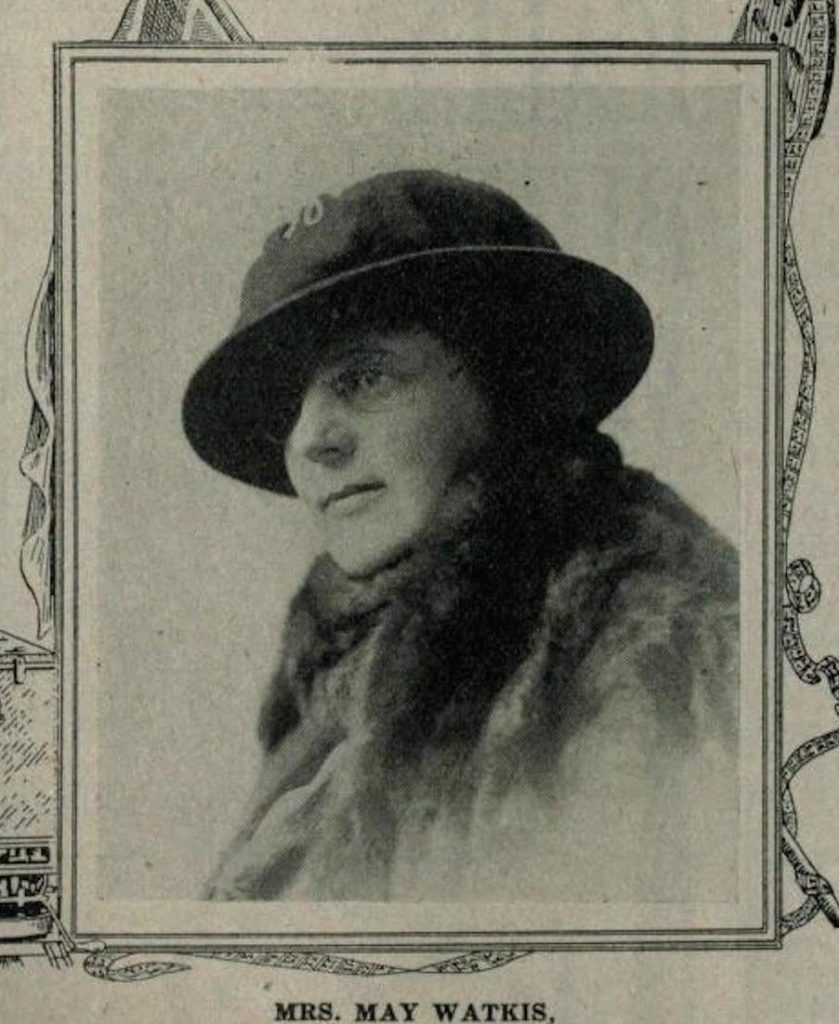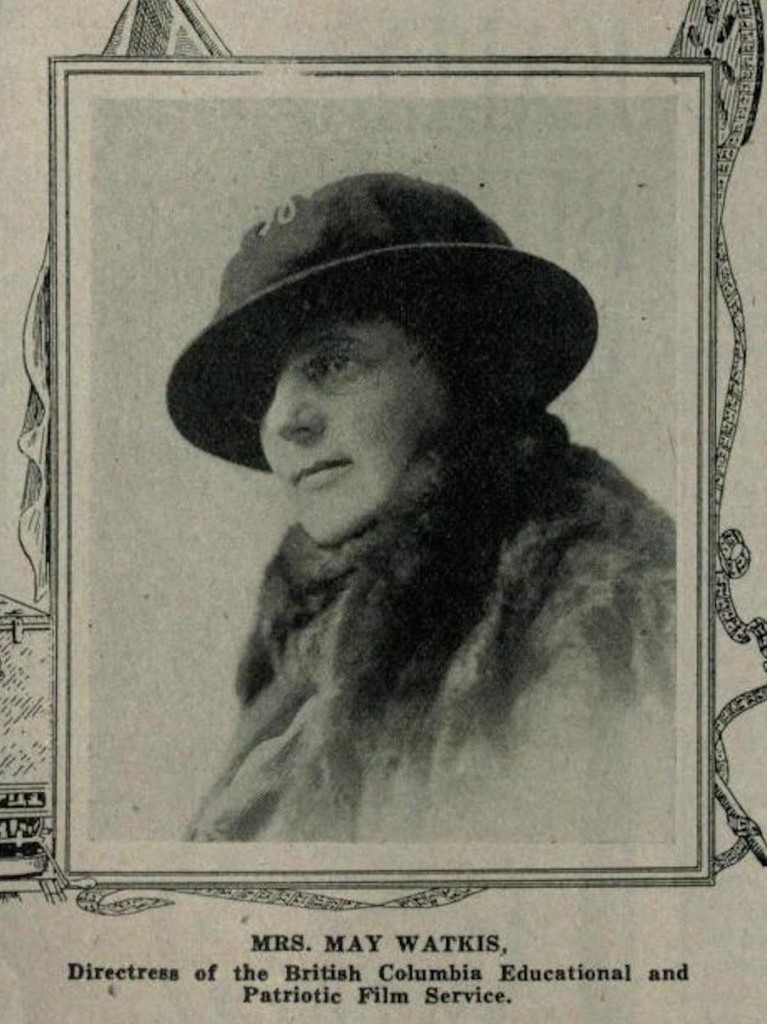One of the early women pioneers in the Canadian film industry was May Watkis, a determined individual who never performed in front of the camera, but who had a long and fascinating career in the government. Having always wanted to work in show business, Watkis began exploring other career possibilities when she soon learned she was not “a type, and would have little chance as an actress,” according to a later interview with Edith M. Cuppage in Maclean’s Magazine (1921, 64). Government records, as well as newspaper articles and secondary sources, paint a contradictory and fascinating picture of Watkis, whose career behind the scenes generates just as many questions as answers.
Watkis was born Hilda May Gowen on July 22, 1879, in Victoria, British Columbia, and spent her early years living there. In 1901, she married Frank T. Watkis (“News of the City” 5) with whom she would go on to have one daughter (“Mrs. M.G. Watkis Dies” 26). According to a 1933 profile in The Vancouver Province, for the first five years of her marriage, Watkis traveled around Europe with her husband, “an accompanist to some of the leading singers of his day” (Marion 38). The couple met when he was on tour in Victoria, when she was about twenty years old, and, according to the article, just out of a “Toronto boarding school.” It seems that Watkis was from a well-to-do family and throughout her life, she regularly appeared in various society columns of the local newspapers.
When the province of British Columbia established a film censorship office in Vancouver in 1913, Watkis reportedly applied for the position of film censor. However, the attorney-general gave the job to a man. Undeterred, she went to the new censor and offered her services as his assistant. He hired her conditionally. The catch was she had to work as his projectionist (Morris 1978, 149). While this sounds like a modest learning assignment by today’s standards, it was virtually impossible to do in 1913 when the projectionists’ union in British Columbia and the nearby US state of Washington was entirely male and refused to teach her. At a time when women did not have the right to vote in British Columbia, learning a skill generally considered to be exclusively “men’s work” was going to be a tall order. Watkis told Maclean’s Magazine in 1921, “having tried to learn by fair means, I was now determined to learn by any means at all” (Cuppage 64). The Maclean’s article reports that Watkis made friends with a local projectionist and asked him to show her the ropes without explaining her motives. Watkis recalled: “he really became quite interested in me, and under his tutelage I projected successfully for several shows…” (64). The new censor was suitably impressed and gave her the job of his assistant. The male union members were reportedly quite upset at the prospect of losing one of “their” jobs to a woman and protested against Watkis’s appointment for more than a month, all to no avail (Morris 150).
An order in council dated May 15, 1914, officially appointed May G. Watkis to be an “Operator” within the “office of the Censor of Moving Pictures,” in Vancouver, at a rate of $100 a month (in effect as of April 1, 1914). Her salary was $10 more than the other appointee in the letter, a male clerk. Digitized public salary records indicate that Watkis continued to work in this capacity for the next few years.
On September 26, 1917, another order in council appointed Mrs. May G. Watkis “of the city of Vancouver” to be an “Inspector” under the Amusements Tax Act, with the same salary of $100 a month (in effect as of October 1, 1917). The Amusement Tax Act, approved in May 1917, imposed a tax on ticket prices at “places of amusements” (theaters, music halls, athletic parks, and more)(“Taxation-Amusements” 331). An article published on September 27 in the Vancouver Daily World also announced Watkis’s appointment to inspector, explaining that the office of the censor, where she had been working, was in charge of enforcing the tax (“New Tax Inspector” 10). According to the article, Watkis’s duties as inspector included “to watch the working of the act and be on a sharp lookout for possible infractions.”
Two years later, in 1919, the provincial film office in British Columbia adopted a mandate to foster economic development for Canadian industry and trade in addition to education. According to Mike Gasher, “an amendment to the Moving Pictures Act in 1920 created the British Columbia Patriotic and Educational Picture Service under the Department of the Attorney-General and introduced a quota provision that required British Columbia movie theatres to introduce each film program with fifteen minutes of films either produced by, or approved by, the Picture Service” (2002, 32). BCPEPS was quite clear about the kinds of films it was to provide: “films…of a patriotic, instructive, educative, or entertaining nature; and, in particular…films…depicting the natural, industrial, agricultural or commercial resources, wealth, activities, development, and possibilities of the Dominion…” (qtd. in Gasher 32-33). The quota also represented “the first government film unit in North America with statutory authority to compel the screening of its productions” (Duffy and Mattison 1989, 32). According to Gasher, however, corporate opposition was incessant and it even became a political issue in the 1920 provincial election. As a result, the fifteen-minute quota was no longer enforced by 1924 (33).
Historian Peter Morris states that BCPEPS was “headed by a woman [Watkis]” (149), but this statement is likely based on the 1921 Maclean’s article, which calls her a “directress” of the organization. Morris claims that when BCPEPS came into existence, “[Watkis] applied for, and got, the job of ‘directress’” (150). Yet official government records contradict this statement and there is no archival evidence that she applied for the “Director” job. In fact, Albert Richard Baker was appointed Director of BCPEPS (Order in Council #0677-1920) with a salary of $300 a month (Order in Council #1429-1920). Instead, on July 7, 1920, Mrs. M.G. Watkis was appointed to the position of “Clerk in the Office of the Director of the British Columbia Patriotic and Educational Picture Service.” Her salary is listed as $125 per month (in effect as of July 1, 1920). While in her own research Juliet Thelma Pollard acknowledges that all government records contrast Morris’s statement (58), she claims that the “bureau was directed from Victoria by Richard Baker with the assistance of May Watkis who ran the Vancouver office and operated as an adjunct to the Game Conservation Board of which Baker was chairman” (43), although she provides no supporting evidence. The 1921 Maclean’s article also indicates that Watkis was working separately in the Vancouver office.

Order in Council appointing May Watkis to position of clerk at BCPEPS, July 1920. Courtesy of the BC Laws website (reproduced under the Queen’s Printer License—British Columbia).
Since no official job descriptions exist, we cannot know for certain what Watkis’s actual daily tasks and responsibilities were. A February 1921 news item (also written by Edith M. Cuppage, who calls her “Mary Watkis”) broadly outlines that Watkis “takes a responsible part in selecting suitable subjects for filming industries and travel scenes which go to all parts of Canada, to the United Kingdom and other parts of the world” (“Woman Film Service Director” 14). While Cuppage calls her the assistant director rather than a clerk, it may be that, as the latter, Watkis acted as an assistant to Baker, and because she was in the Vancouver office while he was in Victoria, she essentially was running the former on an administrative level, although she was not an official “Director” of the organization. It would not be surprising that, as a female clerk, she was in charge of most of the administrative work and taking on more than her official title indicated. While Cuppage and others calling her the “directress” of the organization is erroneous, it is possible that Cuppage was slightly more correct in describing Watkis as the “assistant directress upon whom most of the practical work of the department falls” (64).
The questions concerning Watkis’s role at BCPEPS remain complicated even when more official credits exist. She is credited as a producer, along with BCPEPS, of the travelogue Beautiful Ocean Falls (1920). This title, part of a larger Pacific Coast Scenics series, is, according to Gasher (who gives an incorrect release date of 1926), the only “government-initiated film” to survive (32). According to the entry on the film in The Canadian Educational, Sponsored and Industrial Film Archive database, Library and Archives Canada—which holds a 35mm print of the film—describes it as “a promotional film which stresses the industrial possibilities, the beauties, and the opportunities for enjoyment and recreation of this area” (“Beautiful Ocean Falls” n.p.), with scenes showing power dams, lumber camps, beaches, and mountains, among other locations and subjects. Watkis’s “producer” credit in the database comes from Morris, who likely came to this conclusion based on his belief that she was the “directress” of BCPEPS. The opening credits on the film print only say it was “produced by Pathescope of Canada Ltd. for the British Columbia Patriotic and Educational Picture Service” and make no mention of Watkis (or Baker for that matter) (Todd 2019, n.p.). In reality, if Watkis was involved with this film at all, it was more likely in an administrative capacity in relation to the selection or approval of this film for exhibition.

Copy of the 1921 Census. Courtesy of Library and Archives Canada. May Gowen Watkis appears on line no. 16.
The confusion around Watkis’s role at BCPEPS is further complicated given the inconsistency between official government records and Watkis herself. In a 1921 census, digitized by Library and Archives Canada, she is listed as divorced, the head of the household, and living in Vancouver. (Her recorded age in the census would have her born in 1883.) She gives her occupation as “Director” of the “Picture Service.” Was this her simply exaggerating her role at BCPEPS? Or was this a self-assigned or unofficial indication that she was doing more than her title of “clerk” encompassed, and perhaps running the Vancouver office?
Either way, Watkis’s time at BCPEPS was short-lived. A July 1921 order in council referred to “May G. Watkis, of Victoria,” as an “Inspector of Moving Pictures” who “had made an application for her appointment as a Commissioner for taking affidavits within the Province.” Furthermore, on August 16, 1921, another order in council appointed a Miss H.A. Johnston to be “Clerk” in the office of the Director of BCPEPS, replacing Watkis, who was to be “transferred” (this was all in effect as of July 18, 1921). Moreover, a few months later, in a December 1921 article in the Victoria Times, it was announced that the Vancouver office was being closed to save money: “The work of the office has been transferred to Walter Hepburn, censor of moving pictures” (“Cut Down Film Service” 13). The article noted that this was supposed to be temporary, but was most likely permanent, and that it had to do with the resignation of Dr. A.R. Baker, the director.
Watkis continued to work as an inspector for the rest of her life. According to the BC government’s public accounts from the years 1910 to 1945 (digitized via the University of British Columbia), Watkis received an annual salary (and various traveling expenses) as an inspector under the Amusements Tax Act continuously from 1921 until her death on December 6, 1940, at the Craigflower Hotel in Esquimalt, near Victoria. Her death certificate, held in the BC Archives at the Royal BC Museum, lists the cause of death as suicide by gas poisoning. Watkis is listed as widowed and her occupation is given as “Assistant Inspector, Amusement Tax.” The certificate states that her last day of work was the day before and that she had worked in the industry for about twenty-four years. Her residency is listed as Vancouver. Watkis is buried in the Ross Bay Cemetery in Victoria, British Columbia.
Over the course of her career, Watkis was profiled in the press several times. In addition to the 1921 Maclean’s article, she was interviewed by the Vancouver Daily World in September 1920, in a similarly hyperbolic article that raises more questions about her career. Titled “Provincial Film Exchange Representative Sees Studios and Recounts Experiences,” the piece explains that Watkis spent six months prior to her appointment to her current position (clerk at BCPEPS) in Los Angeles, learning more about film production and studio infrastructure (7). Cuppage’s 1921 Maclean’s interview also connects Watkis to Hollywood, describing it as a “sojourn in California, where she was engaged in the scenario departments of leading producing companies” (64). Watkis’s father was born in California, according to her death certificate, which could account for a trip there, and passenger records show that Watkis arrived in Victoria, via the steamship S.S. President, from San Francisco on July 1, 1920 (mere days before she was appointed clerk) (“May Watkis”). While the aforementioned salary records indicate that she was employed consistently, which raise questions about the actual duration of her stay (to date, no passenger records show when she left Canada), it may be that she went to California on research or business as an inspector. While we cannot be certain that this was the discussed Hollywood trip, in the manifest for the S.S. President, her occupation is listed as inspector in both the “occupation in country from which you came” column and the “what is your intended occupation in Canada” column (“May Watkis”). Since the only primary sources that mention a trip to Hollywood are the Vancouver Daily World piece and the two articles by Cuppage, further research is required to understand the exact dimensions of this reported trip.
Watkis was profiled again in August 1933 in the Vancouver Province. The article repeats her origin story of how she got into the industry, with some colorful details about her projecting her first film upside down (Marion 38). The article calls her the “first woman moving-picture operator in Canada,” and states that in 1916 “when the amusement tax was first imposed she became Vancouver’s first inspector of amusement tax.” Interestingly, the article makes no mention of her involvement with BCPEPS or the organization itself. Instead, it states that after working as an inspector in Vancouver for six years, she was “transferred to her home town, Victoria, and for five years there was inspector of amusement tax for Vancouver Island. She liked this, being her own boss, working by herself, making her own returns.” Starting in 1927, the article continues, “she has been back in Vancouver assisting Mr. Wm. H. Kelly, still in the same office” (38).
As a participant in the emerging Canadian film industry and its affiliated government agencies, Watkis’s career warrants further research, especially given the contradictory nature of many of the sources used to update this profile. However, as a government official and not a filmmaker like fellow Canadian Nell Shipman, for example, Watkis offers a productive way of expanding our notions of women’s “behind-the-scenes” labor during the early years of film. Moving between Victoria and Vancouver, Watkis, working as a projectionist, assistant, clerk, and inspector, actively participated in film exhibition in British Columbia.
With additional research by Dennis J. Duffy, Chantaal Ryane, and Kate Saccone.


